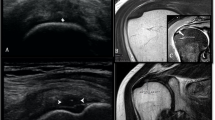Abstract
Purpose
Compare the diagnostic performance of saline and gadolinium shoulder magnetic resonance arthrograms (MRA) in the detection of labral and rotator cuff injury compared to arthroscopy.
Materials and methods
Consecutive patients who underwent a gadolinium or saline MRA followed by arthroscopy were retrospectively reviewed. The reports were reviewed for injuries. A chi square or Fisher’s exact test was performed to compare the MRA and surgery. Kappa values were calculated to correlate diagnosis of tear between MRA and arthroscopy.
Results
There were a total of 58 patients included, including 34 gadolinium arthrograms and 24 saline arthrograms. The accuracy of saline MRA was similar compared to gadolinium MRA in the diagnosis of tears of the supraspinatus (accuracy 0.88 vs 0.74, respectively) and infraspinatus (accuracy 0.88 vs 0.65, respectively) tendons and tears of the anterior/anterior inferior, posterior, and superior labrum, (accuracy 0.79 vs 0.76, 0.71 vs 0.62, and 0.58 vs 0.56), and saline vs gadolinium, respectively. Although there was a trend toward overall better saline MRA performance, a statistically significant difference in the accuracy to detect tears was only noted for the infraspinatus tendon. Interobserver agreement for rotator cuff tears was higher for saline than gadolinium MRA.
Conclusion
Saline MRA was accurate, with no significant differences compared gadolinium arthrograms in the diagnosis of labral and rotator cuff pathology. Given expense, and the potential additional information provided by fluid sensitive sequences over T1 fat-suppressed sequences, consideration should be given to using saline for shoulder MRAs.
Level of Evidence
Level III, Retrospective Cohort Study.



Similar content being viewed by others
Abbreviations
- MRA:
-
Magnetic resonance arthrography
- SLAP:
-
Superior labral anterior to posterior
References
Hodler J, Kursunoglu-Brahme S, Snyder SJ, et al. Rotator cuff disease: assessment with MR arthrography versus standard MR imaging in 36 patients with arthroscopic confirmation. Radiology. 1992;182:431–6.
Flannigan B, Kursunoglu-Brahme S, Snyder S, Karzel R, Del Pizzo W, Resnick D. MR arthrography of the shoulder: comparison with conventional MR imaging. Am J Roentgenol. 1990;155:829–32.
Magee T, Williams D, Mani N. Shoulder MR arthrography: which patient group benefits most? Am J Roentgenol. 2004;183:969–74.
de Jesus JO, Parker L, Frangos AJ, Nazarian LN. Accuracy of MRI, MR arthrography, and ultrasound in the diagnosis of rotator cuff tears: a meta-analysis. Am J Roentgenol. 2009;192:1701–7.
Smith TO, Drew BT, Toms AP. A meta-analysis of the diagnostic test accuracy of MRA and MRI for the detection of glenoid labral injury. Arch Orthop Trauma Surg. 2012;132:905–19.
Tuite MJ. Magnetic resonance imaging of rotator cuff disease and external impingement. Magn Reson Imaging Clin N Am. 2012;20:187–200.
Ricchetti ET, Ciccotti MC, Ciccotti MG, Williams GR, Lazarus MD. Sensitivity of preoperative magnetic resonance imaging and magnetic resonance arthrography in detection of Panlabral tears of the Glenohumeral joint. Arthroscopy. 2013;29:274–9.
McGarvey C, Harb Z, Smith C, Houghton R, Corbett S, Ajuied A. Diagnosis of rotator cuff tears using 3-Tesla MRI versus 3-Tesla MRA: a systematic review and meta-analysis. Skelet Radiol. 2016;45:251–61.
Zanetti M, Hodler J. Contrast media in MR arthrography of the glenohumeral joint: intra-articular gadopentetate vs saline: preliminary results. Eur Radiol. 1997;7:498–502.
Nacey NC, Fox MG, Bertozzi CJ, Pierce JL, Said N, Diduch DR. Incidence of gadolinium or fluid signal within surgically proven glenoid labral tears at MR arthrography. Skelet Radiol. 2019;48:1185–91.
Helms CA, McGonegle SJ, Vinson EN, Whiteside MB. Magnetic resonance arthrography of the shoulder: accuracy of gadolinium versus saline for rotator cuff and labral pathology. Skelet Radiol. 2011;40:197–203.
Steinbach LS, Palmer WE, Schweitzer ME. Special focus session. RadioGraphics. 2002;22:1223–46.
Hajek PC, Sartoris DJ, Neumann CH, Resnick D. Potential contrast agents for MR arthrography: in vitro evaluation and practical observations. Am J Roentgenol. 1987;149:97–104.
Brennan P, Silman A. Statistical methods for assessing observer variability in clinical measures. BMJ. 1992;304:1491–4.
Wilk KE, Reinold MM, Dugas JR, Arrigo CA, Moser MW, Andrews JR. Current concepts in the recognition and treatment of superior labral (SLAP) lesions. J Orthop Sports Phys Ther. 2005;35:273–91.
Pappas ND, Hall DC, Lee DH. Prevalence of labral tears in the elderly. J Shoulder Elb Surg. 2013;22:e11–5.
Schwartzberg R, Reuss BL, Burkhart BG, Butterfield M, Wu JY, McLean KW. High prevalence of superior labral tears diagnosed by MRI in middle-aged patients with asymptomatic shoulders. Orthop J Sports Med. 2016;4:2325967115623212.
Gulani V, Calamante F, Shellock FG, Kanal E, Reeder SB. Gadolinium deposition in the brain: summary of evidence and recommendations. Lancet Neurol. 2017;16:564–70.
McDonald RJ, McDonald JS, Kallmes DF, et al. Intracranial gadolinium deposition after contrast-enhanced MR imaging. Radiology. 2015;275:772–82.
Guo BJ, Yang ZL, Zhang LJ. Gadolinium deposition in brain: current scientific evidence and future perspectives. Front Mol Neurosci. 2018;11:335.
Darrah TH, Prutsman-Pfeiffer JJ, Poreda RJ, Ellen Campbell M, Hauschka PV, Hannigan RE. Incorporation of excess gadolinium into human bone from medical contrast agents. Metallomics. 2009;1:479–88.
Kralik SF, Singhal KK, Frank MS, Ladd LM. Evaluation of gadolinium deposition in the brain after MR arthrography. Am J Roentgenol. 2018;211:1063–7.
Author information
Authors and Affiliations
Corresponding author
Additional information
Publisher’s note
Springer Nature remains neutral with regard to jurisdictional claims in published maps and institutional affiliations.
Rights and permissions
About this article
Cite this article
Singer, A.D., Rosenthal, J., Umpierrez, M. et al. A comparison of saline and gadolinium shoulder MR arthrography to arthroscopy. Skeletal Radiol 49, 625–633 (2020). https://doi.org/10.1007/s00256-019-03338-2
Received:
Revised:
Accepted:
Published:
Issue Date:
DOI: https://doi.org/10.1007/s00256-019-03338-2




